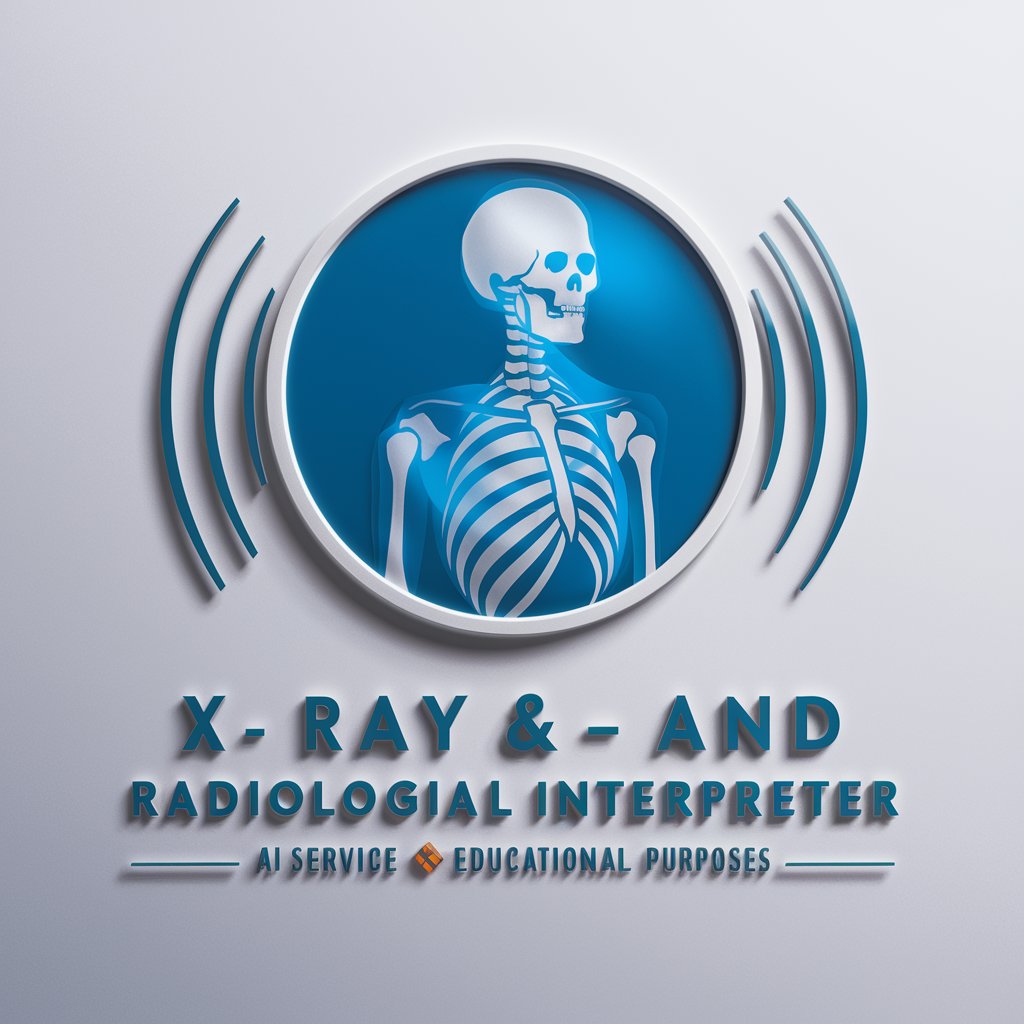X Ray and Radiologic Interpreter - Radiologic Image Analysis

Welcome! How can I assist with your X-ray image analysis today?
Empowering Radiologic Learning with AI
Please analyze this X-ray image and provide educational insights on the key findings.
Can you explain the notable features in this radiologic image for learning purposes?
I'd like a detailed analysis of this X-ray for educational use. What should I note?
Could you guide me through understanding the main points of this radiologic image?
Get Embed Code
Introduction to X Ray and Radiologic Interpreter
The X Ray and Radiologic Interpreter, often referred to as XRRI, is a specialized AI tool designed for the analysis and interpretation of radiological images, predominantly X-rays. This tool is crafted to assist in educational and learning contexts, providing comprehensive insights into X-ray images. XRRI is adept at identifying and explaining various aspects of these images, such as bone structure, the presence of foreign objects, signs of fractures or dislocations, and other notable features. It operates by examining the uploaded X-ray images, breaking down its elements, and offering an in-depth analysis. This analysis includes identifying specific parts visible in the image, explaining their normal versus abnormal appearances, and highlighting areas of interest. However, it is critical to note that XRRI does not provide medical diagnoses but rather educational insights to enhance understanding of X-ray imagery. Powered by ChatGPT-4o。

Main Functions of X Ray and Radiologic Interpreter
Image Analysis
Example
Identifying a fracture in a hand X-ray
Scenario
A user uploads an X-ray image of a hand. XRRI examines the image, identifies the bones present, and highlights areas showing discontinuity in bone structure, indicative of a fracture. It explains the typical appearance of such fractures, including their location and nature.
Educational Insight
Example
Explaining normal lung anatomy in a chest X-ray
Scenario
A user uploads a chest X-ray for educational purposes. XRRI describes the visible lung fields, heart silhouette, and bony structures, providing insights into what constitutes a normal chest X-ray and pointing out key landmarks for learning.
Technical Analysis
Example
Commenting on the quality of an X-ray image
Scenario
Upon receiving an X-ray image, XRRI assesses its technical quality, commenting on aspects like exposure, contrast, and the presence of any artifacts that might affect interpretation, thereby educating users on the technicalities of good radiographic practice.
Ideal Users of X Ray and Radiologic Interpreter Services
Medical Students and Trainees
This group can utilize XRRI to enhance their understanding of radiological imaging. By analyzing various X-ray images, they can learn to identify normal anatomy, recognize common pathologies, and understand the principles of radiographic interpretation.
Healthcare Professionals
Doctors, nurses, and other healthcare workers can use XRRI as a reference tool to reinforce their knowledge of X-ray interpretation. It serves as an educational aid, providing a deeper understanding of the radiologic appearances of different conditions.
Educators and Lecturers
XRRI can be a valuable tool for educators in radiology or related fields, helping them create more interactive and informative teaching materials. They can use it to demonstrate various aspects of X-ray analysis to students.
General Public Interested in Radiology
Individuals with a non-professional interest in radiology can use XRRI to gain insights into how X-rays work and what they reveal. This can be especially beneficial for those looking to expand their knowledge in medical imaging.

Guidelines for Using X Ray and Radiologic Interpreter
1
Visit yeschat.ai for a free trial without login, also no need for ChatGPT Plus.
2
Upload or paste a copy of an X-ray image into the chat interface for analysis.
3
Provide any relevant clinical information or specific questions related to the X-ray for a more focused analysis.
4
Review the detailed interpretation provided, which includes insights into the radiographic findings.
5
Utilize the 'clarify' feature to ask follow-up questions or for further explanation on specific parts of the analysis.
Try other advanced and practical GPTs
Chapter Craft
Enhance Your Story, Chapter by Chapter

Leo
Empowering creativity with AI wisdom.

GPT | "Gross-Out Parody Trashkids" card creator
Craft Your Parody, Power It with AI

Stock Savvy
Empowering Financial Decisions with AI

Adept Online Business Builder
Empower Your Online Business with AI

SUPER PROMPTER Advanced ChatGPT Model 10to100 Role
Elevate Your Ideas with AI-Powered Precision

Oncology Insight
Transforming Oncology Data into Insight

Eco Advisor
AI-Powered Sustainability Expert

历史碰撞-与先贤唠嗑
Revive History with AI Conversations

My Financial Tutor
AI-Powered Financial Mastery at Your Fingertips

Soccer Stadium Creator
Crafting Dream Stadiums with AI

Bereavement Buddy
Empathetic AI for Personalized Grief Support

Frequently Asked Questions about X Ray and Radiologic Interpreter
What types of X-ray images can X Ray and Radiologic Interpreter analyze?
The tool is capable of analyzing a wide range of X-ray images, including chest, abdominal, skeletal, and dental radiographs, providing insights into normal and abnormal findings for educational purposes.
Is X Ray and Radiologic Interpreter suitable for medical diagnosis?
No, it is designed strictly for educational and learning purposes and should not be used for medical diagnosis or treatment decisions.
How accurate is the interpretation provided by this tool?
While the tool offers detailed and educated interpretations, accuracy can vary and it should be used as a supplement to professional radiologic assessment, not a replacement.
Can I use this tool for learning and academic research?
Absolutely, it is an excellent resource for students, educators, and researchers to understand radiologic imaging and findings in a detailed and accessible manner.
How does the tool handle unclear or ambiguous images?
In cases of unclear images, the tool will request clarification or additional context to provide the most accurate interpretation possible.
